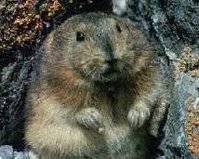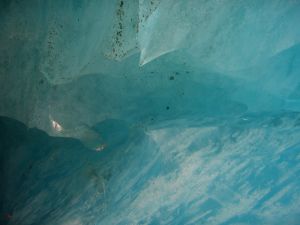Glacier and Iceberg Facts
Here are a few quick facts about glaciers and icebergs. Icebergs are included simply because they come from glaciers.
Extent of glaciation
In the modern world about 10% of land area (roughly 15,000,000 square kilometres) is covered by glaciers, but during the last Ice Age glaciers covered about 32% of the total land area.99% of modern glacial ice is located in the Arctic and Antarctic.
In some parts of the Antarctic, the ice has been measured as being over 4,200 meters thick.
The Antarctic ice sheet has been in existence for at least 40 million years.
Glaciers store between 70% and 80% of all the freshwater in the world.
The land underneath parts of the West Antarctic Ice Sheet may be up to 2.5 kilometres below sea level. The weight of the ice pushes the land surface down in a process called isostatic adjustment. The south of the United Kingdom has been slowly rising since the last ice age , due to the weight of all that ice being removed when it melted!
North American Glacier Facts
In the United States, glaciers cover over 75,000 square kilometres, with most of the glaciers located in Alaska .There are nearly 100,000 glaciers in Alaska, and most of them don't have names. North America's longest glacier does have a name. It's the Bering Glacier in Alaska, and it is 204 kilometres long.
Washington and Alaska are the only two states in the United States which get a significant percentage of their water supplies from glacial sources. In Washington State, glacial melt water provides 1.7 trillion litres (470 billion gallons) of water every summer.
In total Alaska's glaciers empty over 50,000 billion gallons of water into streams and rivers every summer . That's half of all the water that flows into the worlds oceans!
Nearly all the glaciers in Alaska seem to be are melting. The thinning rates (the speed at which they melt) in the last 5 years have been calculated at over twice those seen in previous years.
Life on Glaciers.
 Lemmings,
small rodents that look like voles, may also be found on the glacial ice though
they much prefer the rock and soil on either side of them. They don't actually
live on the glacier. The popular belief about lemmings leaping off cliffs isn't
true either. They may be small, but they aren't that stupid. The whole idea
came from a very carefully designed Disney film.
Lemmings,
small rodents that look like voles, may also be found on the glacial ice though
they much prefer the rock and soil on either side of them. They don't actually
live on the glacier. The popular belief about lemmings leaping off cliffs isn't
true either. They may be small, but they aren't that stupid. The whole idea
came from a very carefully designed Disney film.
Other life on glaciers includes small insects blown there by the wind, some algae that survive on the crushed rock within the ice, and assorted bacteria.
Glacial Retreat and Advance
Tropical glaciers in Africa have decreased in area by 60 to 70% on average since the early 1900s.
The vast majority of all Himalayan glaciers have been retreating and thinning over the past thirty years, with accelerated losses over the last decade. Countries such as India rely on glacial melt water for much of their fresh water supplies. If glacial melt waters dry up, such countries will have to rely on just the monsoon rains - a very unreliable source of water.
Arctic glaciers have all been receding (retreating), apart from in Scandinavia and Iceland where more precipitation has resulted in glacier growth. Large sections of the Greenland ice sheet (12% of the world's ice)appear to be sliding towards the sea.
If all the land ice melted, worldwide sea levels would rise by approximately 70 meters - that's partly why scientists are so worried about global warming.
From the 17th century to the late 19th century, the world experienced a "Little Ice Age," when temperatures were consistently cool enough for significant glacier advances.It is thought that this Little Ice Age is what prevented the Vikings from really exploring North America...the bad weather in Greenland made farming impossible and eventually led to the death of the settlers there. It is believed that the Greenland settlements were the bases from which the Vikings made their voyages to North America.
The Kutiah Glacier in Pakistan holds the record for the fastest glacial surge ever recorded. In 1953, it advanced more than 12 kilometres in three months, averaging about 112 meters per day. That's just under half a meter in the time it takes to read this page!
Where do icebergs come from?
Most of the icebergs found in the North Atlantic come from about 100 glaciers along the Greenland coast. A few others can be traced back to glaciers in the Eastern Canadian Arctic Islands. The glaciers of western Greenland, where 90% of Newfoundland's icebergs originate, are amongst the fastest moving in the world, up to 7 km per year. As the ice advances into the sea, it breaks off because it is no longer supported from below.
Do we know many icebergs are there at any one
time?
Approximately 40,000 medium to large sized icebergs calve annually in Greenland
and about 1 to 2% (400-800) of those make it as far south as 48 degrees north
latitude (St. John's). The numbers vary greatly from year to year and seasonally.
Spring and early summer are the best times for icebergs. Icebergs that drift
into shipping areas are closely monitored from ships and from satellites. Nobody
wants another Titanic disaster!
How old are icebergs?
Icebergs usually take about a year between being
calved from a glacier and reaching Newfoundland. They
usually hang around in cold arctic bays melting slowly (or not at
all in winter) for about a year, then eventually move through the
Davis Strait and into the Labrador current. Once they pass the Davis Straight
they usually have about one year left before they melt. The further south they
drift, the quicker they melt. The glacial ice that actually forms the icebergs
though may be more that 15,000 years old.
How much does an iceberg weigh?
It all depends on how big they are! The larger ones can weigh more than 10 million
tonnes. Icebergs are classified according to size, and are named as follows...
Very large, large, medium and small bergs. Icebergs smaller than 'small bergs' have interesting names. After small bergs there are " bergy bits" and finally "growlers". Growlers are about the size of a small car.
If you really want an average value, the average iceberg weight for the Grand Banks area is one to two hundred thousand tonnes.
How cold are icebergs?
Inside the iceberg the temperature is about -15 to -20 degrees C.
The surface temperature is determined by the temperature around the berg.
How big was the largest iceberg ever recorded?
The largest Northern Hemisphere iceberg on record was discovered near Baffin
Island in 1882. It was 13 km long, 6 km wide and its height above
water was about 20 m. To put that into context, if you melted a berg that big,
you'd have enough water for each person in the world to drink two litres a day
for 2 years!
In Antarctica the bergs can be even bigger. In 1987 an iceberg with an area of 6350 square kilometres broke from the Ross ice shelf. That berg had a mass of around 1.4 trillion tonnes and could have supplied everyone in the world with 2 litres of water per day for almost 330 years!
Why does glacial ice look blue, but snow looks white?
Glacial ice only looks blue when it has become very dense. Years of compression
slowly increase the density of the ice, from loose and fluffy snow to extremely
dense ice. As it is compressed, the air trapped between the original snow flakes
is forced out. When glacier
ice becomes extremely dense, the properties of the ice change. It now absorbs
all the colours in the spectrum except blue, which it reflects. This is why
it looks blue.From this, you have probably worked out that it's the trapped
air in snow that makes it reflect almost all the spectrum and appear white.
So, white ice is new ice, blue ice is old ice.
Weird Iceberg Facts
Antarctic ice shelves may calve icebergs that are over 80 kilometres long. If that was a flat road, it would take you about 17 hours to walk from one end to the other
Almost 90% of an iceberg is below water--only about 10% shows above water.
There has been at least one recorded murder on an iceberg.
In the 6th century an Irish monk recorded that he "passed by towering crystals that rose up to the sky" when he wrote an account called "Voyage of Saint Brendan the Abbot". During his voyage, he recorded that his boat " was raised up on the back of a sea monster, passed colossal crystals that rose from the sea and had blazing rocks thrown at it by the natives of a large island." Historians think he was referring to whales, icebergs and Iceland's volcanoes. It is possible that Saint Brendan discovered America almost a millennium before Christopher Columbus got there.
During the second world war there was a top secret plan (called Habbakuk) to
use icebergs as aircraft carriers.
In June 1875 the schooner "Caledonia" sank off Newfoundland,
but the crew of 82 all managed to climb to safety on an iceberg. They were all
rescued.
The word "iceberg" probably comes from "ijsberg",
which means "ice hill".
Melting iceberg ice makes a fizzing or pinging sound.
This is caused by the popping of tiny compressed air bubbles in the
ice. The air that escapes is, of course, as old as the ice. It may have been
trapped there for 15,000 years or more!
Icebergs may also make sudden very loud booming and cracking sounds without
any sign of movement or calving. The sounds are caused by stress cracks forming
in the ice. It's a very scary experience when you are close to the berg
and it starts making noises!
In Newfoundland iceberg ice is now a commercial product. Ice is collected and
sold as bottled water and used in the production of vodka.
Growlers, or small iceberg pieces, really do make a growling noise when they
bob up and down into the water.
![]()
